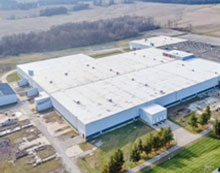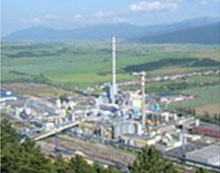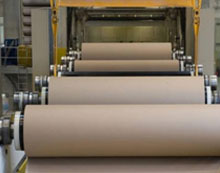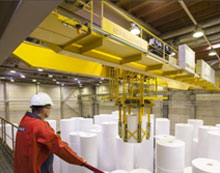Transformation
- Home
- Business Transformation
BUSINESS TRANSFORMATION

Amcor, first founded in Australia and now headquartered in Switzerland
_____________
BUSINESS TRANSFORMATION BASED OPERATIONAL EXCELLENCE
_____________
TRANSFORMATION OF PACKAGING AND PAPER INDUSTRY AND OTHER
_____________
Packaging and Paper Industry
→
_____________
OPERATIONAL
EXCELLENCE OF
PRODUCTS PACKAGING AND PAPER INDUSTRY
Transformation in Products Packaging and Paper Industry
A full potential transformation can raise a company’s profitability, cash flow, top-line growth, and value to a completely different level. Paper and packaging companies that have achieved a full potential transformation. Successful companies embrace clear purpose, full alignment, accountability, and sprint-based prioritization of actions.

Amcor
By building scale in existing markets, expanding its geographic scope, and acquiring several Italian companies with a strong European presence, Fedrigoni became one of the top players in self-adhesive labels worldwide. It also embedded sustainability into internal operations and its day-to-day business, developing circular products such as specialty paper made of 40% to 100% recycled material as well as paper combining pulp and alternative fibers such as cotton, hemp, and linen. Finally, it also cut costs and optimized operational excellence.

For every company that has invested at the right time and achieved game-changing operational and commercial results, there have been many more that have faced declining profitability and serious balance sheet issues. Given this wide variation, CEOs and shareholders have prioritized understanding how to generate the most attractive returns and make the most out of their existing production assets.
Transformation is used widely in the business world, and when implemented successfully, this plan can dramatically raise the company’s performance to a completely different level in terms of its profitability, cash flow, top-line growth, and value. This success often leads to an increased ability to make bold new investments in new production capacity and R&D. These days, such transformation plans also often include a concrete sustainability plan that outlines how to get toward lower (or ideally zero) carbon emissions within a given timeline, often through site energy-efficiency savings or investments in non–fossil fuel energy.
Successful companies articulate a clear purpose and value creation plan or a roadmap to achieve their full potential transformation. They align fully across the organization and split bigger key initiatives into multiple shorter sprints. Executives meet regularly to ensure that performance is transparent, roadblocks are quickly cleared, and decisions are quickly made. Finally, they ensure that the best talent leads the transformation, and they honestly evaluate where they are missing certain skills, hiring externally to fill those gaps.
Everything on the broad agenda cannot be successfully executed at the same time. Instead, successful companies identify and quantify the relevant ways to create value. Three different ways that top-quartile companies Bain has worked with have employed specific value levers as part of their full potential transformation include revamping their portfolio strategy, stepping up their commercial and operational excellence, and improving their performance through cost transformation and next-generation sourcing.
Revamping portfolio strategy: Leading companies anticipate and react to changing market demands, and they adjust their portfolio accordingly. Early lessons can be learned from paper companies that switched some years ago from declining products such as graphic paper to producing higher-demand packaging products such as carton board or containerboard. Revamping their portfolios often involved divesting or spinning off lower-demand products, closing certain paper mills if they were too old or costly to convert, or transforming machines to produce the higher-demand products.
Today’s leaders also realize that transforming one’s portfolio means accepting that they will need to close certain plants and make new investments to convert machines into growing and attractive product grades. Finally, leaders will upgrade the commercial organization to effectively sell the new products to new customers. This could entail training sales teams to sell carton board or molded fiber products to fast-moving consumer goods companies, retail chains, or quick-service restaurants, instead of selling graphic paper to publishers.
Stepping up commercial and operational excellence

Many full-scale transformations rely on improving commercial and operational results across dozens of production sites. One packaging producer, for example, started by setting high ambitions to improve operations vs. the baseline. It began by seeking full transparency of what good looks like on a very granular level. On the operations side, supervisors tracked how workers did on key performance indicator dashboards in every plant for every shift, how the shift changeover was managed, and many other details. They did this to establish their ambition and where certain teams and plants needed to close the gap.
The company brought in the equipment manufacturers (who also functioned as consultants) to share best practices and help the teams accomplish operational excellence. Finally, it connected those teams focused on operational excellence with the teams working on commercial excellence and sourcing excellence to ensure that operational excellence improvements were not, for instance, negatively impacting the commercial team. Sourcing was looped in early on to help find which materials, recipes, and suppliers were needed to optimize product cost.
Improving performance through cost transformation and next-generation sourcing: Other companies have improved their cost structure and upgraded sourcing to stay competitive and drive a multiyear transformation. For one company, this included coordinating procurement for key product categories so that every single mill did not negotiate with suppliers separately, but instead, they could take advantage of volume discounts and more strategic dialogues with select suppliers.
Analyzing the data enabled the company to determine a more efficient balance when choosing among the share of fiber to produce internally, to source from external suppliers, or to purchase on the open market. Big data analysis on varied performance across all products and sites helped manage demand and identify how it could reduce the cost of chemicals and energy within its operations—for example, through calibration of recipes and consumption in the production. As a result, this company managed to reduce costs, improve collaboration between sourcing and key business stakeholders, and upgrade the supplier management and overall sourcing strategy significantly. Sourcing teams were involved early and throughout the full transformation process so as to be more cost efficient if the team were to be sought out to alter the product recipe, and they would rethink sourcing to reduce the quantity of the most expensive ingredients, which are typically chemicals.
How to succeed in a full potential transformation

Successful companies begin their transformations with a diagnostic phase to establish a starting point, followed by a design phase to specify the actions and planned impact. It is in the implementation stage, however, where the winners emerge. These companies embrace:
a clear purpose
→
the principle that talent is king
→
full alignment and accountability
→
sprint-based prioritisation
→
performance transparency
→
fast decisions
→
Clear purpose: The CEO articulates why the company needs to do things differently, what the world will look like if it succeeds, and the specific motivations for different roles within the organization. Perhaps the company is chronically less profitable than competitors or a new private equity owner is aiming for a successful exit in five years or has an ambition to achieve global leadership through M&A and consolidation. The key is that the leadership team and the broader organization feel motivated to take the journey toward that joint ambition.
Talent is king: Transformations are disruptive and can lead to attrition as well as new skill requirements. Leaders identify the best talent at the firm to lead the transformation, rather than simply the employees available to do so. These top performers are freed up from other tasks so that they will be the best sponsors to ensure buy-in for the transformation. Looping in top talent before companywide communications can help them feel integrated in leading change. And diversity is reflected at every level of employment—from the factory line to the C-suite.
Full alignment and accountability: The top team and key profit-and-loss owners embrace the approach and its urgency. Every initiative has clear owners and sponsors, and the broader organization is informed of plans and regularly updated on progress through all-hands town hall–style meetings. A clear sponsorship spine extends through all levels to ensure buy-in and help anticipate risk early on. Employees hear about transformation directly from their managers, who can explain why the change is critical and how it will impact employees’ day-to-day work.
Sprint-based prioritization: Broad transformations often cover countless different initiatives. To ensure progress, work is split up into multiple shorter sprints, without losing sight of long-term objectives. The most critical enablers and highest-value initiatives are front-loaded and operationalized within 4- to 10-week sprints, during which the working team is onboarded and key improvements are introduced. After the sprint is finished, leaders communicate results to all relevant stakeholders and map them against long-term ambitions.
Performance transparency: Dashboards showing progress in transformations too often tend to migrate toward showing green lights across, whereas the real point of tracking is to identify issues and react to those quickly. Successful companies seek transparency on performance and a “red is good” mentality in tracking progress. If waste percentages at a converting plant are not dropping, for instance, or if most price increases are leaking out, the leadership team is notified immediately.
Fast decisions: During well-run transformations, executives meet weekly or biweekly to address how specific roadblocks or delays in a given workstream can be mitigated. For instance, a recipe optimization effort requires a new chemical supplier in order to succeed, or the speed calculation methods across a company’s board machines need to be harmonized or the salespeople cannot charge the correct transportation costs because the data is not available on time. Quick, pragmatic decisions are made to course-correct the initiatives that are struggling, and all employees from the C-suite to the front line accept that sometimes teams make the wrong decisions and need to course-correct.

Some of the existing articles that are found in web are:
The Paper and Packaging Industry Faces a Biodiversity Crisis
→
Which Packaging Substrates Are the Most Sustainable?
→
How Paper and Packaging Companies Can Catch Up in Commercial Excellence
→
Putting Sustainability to Work in Paper and Packaging
→
The State of Private Equity and M&A in the Paper and Packaging Industry
→
WESTROCK | AMCOR |
TETRA PAK | STORA ENSO |
OJI HOLDINGS | SMURFIT KAPPA |
_____________________________
Our consulting on business transformation is managed by a dedicated team from Australia.

Business transformation is an umbrella term that describes all transformation processes – including operational, cultural, and digital – that a business goes through in order to cope with shifts in the market.
The six stages of transformation are Realize, Release, Rebound, Reinvent, Resurrect and Respond. Awareness of these stages allows readers to understand where they have been, where they are now, and where they are heading.
The service industry comprises over 70% of the Australia GDP. It dominates the economy, which employs over 79% of the labour force, other major industries include tourism, healthcare, media, finance, and mining.
Food manufacturing is the leading industry in the manufacturing industry with 18 companies in the top 100 manufacturing companies.
During the last five reported years the exports of Australia have changed by $139B from $204B in 2016 to $343B in 2021. The most recent exports are led by Iron Ore ($118B), Coal Briquettes ($54.3B), Petroleum Gas ($39.2B), Gold ($17.6B), and Wheat ($7.36B).
Among Australian consumers the two most popular categories for online purchases are clothing and Shoes.
Industry Share of Output in key sectors in Australia are Mining 14.3%, Finance 7.4%, Health and Education 12.8%, Manufacturing 5.7%, Construction 7.1%.
Not only is BHP the biggest company listed on the Australian Securities Exchange (ASX), but it is also the biggest mining company in the world by market cap, ahead of Rio Tinto and Glencore.
AusTTA is Australia’s premier professional body for Transformation experts. AusTTA’s purpose is to:
Improve professionalism in the planning, execution, and implementation of (Transformative) plans in the private and public sectors
Qualify and Professionalise the role of Transformation
Assess and upgrade the expertise, experience and knowledge of Transformation Professionals
Advocate and raise the profile of transformational leadership as a profession
Facilitate positive and proactive engagement with viable enterprises undergoing disruption / change.
Advocate early intervention to promote increased optionality.
Australia has a regard and follow up for transformation in any industry in a positive direction.
If you need Australian hands to solve your industry’s challenges on business transformation, you contact our MCGR Australia team. MCGR Australia team has experience in packaging and Paper, Iron Ore, Coal, Petroleum Gas, Gold and Wheat. It also has expertise in Mining, Finance, Health and Education, Manufacturing and Construction. |

PACKAGING AND PAPER INDUSTRY |
MINING INDUSTRY |
FINANCE INDUSTRY |
HEALTH AND EDUCATION INDUSTRY |
MANUFACTURING INDUSTRY |
CONSTRUCTION INDUSTRY |
URBAN DEVELOPMENT |
_____________________________